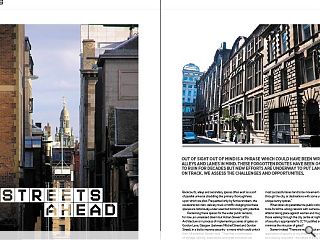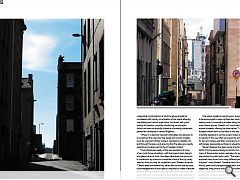Rediscovering lanes and backcourts
25 Oct 2012
Out of sight out of mind is a phrase which could have been written with alleys and lanes in mind. These forgotten routes have been on the road to ruin for decades but new efforts are underway to put lanes back on track. We assess the challenges and opportunities.
Backcourts, alleys and secondary spaces often exist as a sort of parallel universe straddling the primary thoroughfares upon which we plod. Frequented only by furtive smokers, the occasional bin man, delivery truck or traffic dodging taxi these spaces are notoriously under-used but brimming with potential.Reclaiming these spaces for the wider public remains, for now, an unrealised dream but Adrian Stewart of Do Architecture is in process of implementing a series of gates on Gordon Lane, Glasgow (between Mitchell Street and Gordon Street), in a bid to improve security - a move which could unlock their full potential. Stewart said: “I feel that a combination of signage, lighting, destinations and street activation can contribute to improved utilisation of the lanes; however the most successful lanes tend to be movement desire lines through the city, or destinations with some unique quality, or unique sunny spaces.”
When lanes do penetrate the public consciousness it tends to be for all the wrong reasons with numerous instances of sex attacks taking place against women and muggings against those walking through the city centre at night - but what level of security is appropriate? Is CCTV justified and how do you minimise the intrusion of gates?
Stewart noted: “There are no clear cut answers to the application of security to city lanes, and this must be considered on a case by case basis - the nature of a city often reveals beautiful places but sometimes deposits spaces which are undesirable. Combinations of all of the above should be considered with priority on activation of the space, allowing overlooking and natural supervision, combined with good quality illumination - possibly introducing soundscapes (which we have successfully utilised at a formerly problematic pedestrian underpass in central Brighton).
“Where it is deemed necessary that gates are required, as is sometimes the case, then the design and impact of gates must be cognisant of their context, maintaining visibility into and through the lanes, and ensuring that the gates are visually receding and subservient to the immediate context.”
The architectural quality of the rear elevations of some of our most famous buildings, with their pared down designs and glazed ceramic brick, have been described as a precursor to modernism by some and constitute a face of the city rarely seen but how can they be capitalised upon? Stewart observes: “Certain areas are noteworthy, others less so and case by case acknowledgement of each space is required to create a delicate balance. Architecturally interesting lanes tend to promote self-supervision and natural policing, these spaces were designed for servicing the buildings and their aspiration to gather daylight often leads to some refreshingly simple facade organisation.”
One option looked at was for pubs, shops and restaurants to be encouraged to open up their rear courts for additional seating, even incorporating arcades along some of our more central spaces. Stewart isn’t convinced that this is the answer however, offering the observation: “I would question if people would want to use them in this way - they were originally designed as service access routes and largely remain successful in this use, often serving as the only available areas for bins and refuse, and often not receiving much sunlight and with largely inaccessible surfaces to wheelchair access.”
Stewart believes the ideal course of action is to ban traffic from the lanes entirely but admits this is unrealistic as many of these routes remain necessary for servicing, limiting intervention to public realm work. “The lanes have been explored many times from many different perspectives over the years” notes Stewart, “however their function shifts as the city grows and changes around them, both positively and negatively, they provide some wonderful alternative glimpses of the ‘hidden city’ while also exhibiting some very dangerous qualities for personal security - any strategic appraisal would need to be reviewed every 5 or 10 years to keep up with the modern evolving city.”
Read next: The Golden Section
Read previous: Working in China
Back to October 2012
Browse Features Archive
Search
News
For more news from the industry visit our News section.
Features & Reports
For more information from the industry visit our Features & Reports section.




